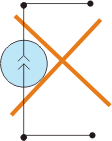An ideal, independent current source is a dipole which has the capability to impose the current it provides, regardless of the voltage applied to its terminals.
The symbol for representing a current source is:
![]()
There aren't any specific symbols for representing direct current sources (DC), respectively alternating current sources (AC).
The equation that characterizes an ideal current source is:

When we connect a current source with another passive element, we obtain a circuit in which the current  flows.
flows.

Figure 5 - Ideal current source supplying a passive element
The potential difference  between its terminals, depends on the element the source supplies:
between its terminals, depends on the element the source supplies:
• in the case of a current source, its terminals can be linked between them. In this case, the voltage  between its terminals is zero and consequently the power it provides,
between its terminals is zero and consequently the power it provides,  , is zero;
, is zero;
• a current source can never be left in an open circuit because this would correspond to the cancellation of the current it supplies; there must always be a circuit in which the current should flow; as a current source imposes  , an open circuit imposes
, an open circuit imposes  .
.
• two current sources can be series connected if they have the same value of the current; thus, by using Kirchhoff's 1st Law we obtain  , which is valid only if the two values of the current are equal.
, which is valid only if the two values of the current are equal.
 |
 |
 |
Figure 6 - Ideal current source in short-circuit, in open circuit, and two current sources series connected.